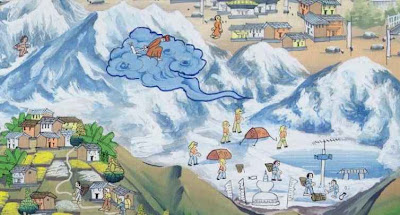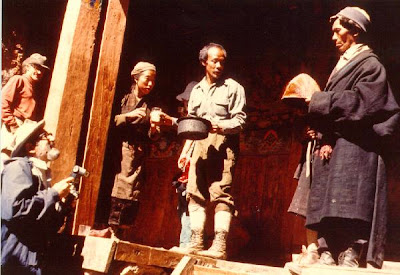Back in the 1970s, Nepal became famous as the culmination of the hippie trail overland from Europe via Istanbul, Teheran, Kabul, Peshawar and Delhi. The allure of this relatively unknown destination, closed to Western tourism until the 1950s, was based on five interrelated amenity assets: the Himalayas (especially Mt. Everest), the Sherpas, Eastern religions (particularly Tibetan Buddhism and Hinduism), world-class ganja, and the yeti (a.k.a. abominable snowman). Nepal's exotic mystique attracted a market that sprang directly out of the 1960s counterculture, young independent backpackers looking for spiritual, pharmaceutical and outdoor adventure. Trekking became the mainstay of Nepal's tourism industry.

Kathmandu artist's representation of Rolwaling Valley, commissioned by author. Note the yeti scampering over the snow slopes -- a typical detail.
My first trip to Nepal (Dec. 1974-March 1976) was motivated by a long-standing interest in only one of those five compelling assets: the yeti. Whenever I mention to someone that I have this interest, I am inevitably asked whether I also believe in the Loch Ness monster and extra-terrestrials. In some cases the subtext is clearly dismissive: Is this a limited intellectual impairment, or are you completely dysfunctional? In most cases, the question probably represents a sincere effort to approach a speculative issue in the most economical way: first, assess the scope of the hermeneutic net, then devise an evaluative strategy according to the nature of evidence.
In fact, that is how I approached the issue itself, and it is also how you will probably want to approach my own testimony, so let me start with a rather long-winded but pertinent anecdote that bears directly on eye-witness credibility.
I met Lhundrup Tsering in 1975, when I was 25 and he was 30. For more than a year he tutored me in colloquial Tibetan. According to the terms of his engagement, all conversation had to be carried out in Tibetan, and since my command of the language was not good, we had no protracted discussions on serious topics. However, he was aware that I wanted to learn Tibetan so that I could go to the Khumbu region of eastern Nepal and find out more about the yeti. (Sherpas speak a distinct dialect of Tibetan, but I had found no one capable of instructing me in it.) In 1981 I returned to Nepal with a grant to study Tibetan oral literature in the Khumbu, but still motivated primarily by curiosity about the yeti. During the summer monsoon, I again hired Lhundrup for Tibetan lessons. I explained to him my dual purpose, of course, and he suggested I interview his uncle, who lived in Mussora, India. This man was a "bap-drung," a shamanic raconteur in the authentic bardic tradition. I decided I would look for him if nothing turned up in Khumbu.
As it turned out, there had been no yeti reports in the district since 1975. That was not a big problem in itself, since my goal was to assess the role of yeti accounts in Sherpa society. Were yeti tales told around the evening fire along with other stories of supernatural figures? Were children disciplined with threats of yeti visitations similar to those of Western boogeymen? Were yeti stories "sold" to tourists or exchanged for prospective compensation? In short, I was looking for a folkloric or other social role that would explain persistence of yeti accounts in the absence of an actual entity. Failure to identify any such social function would suggest that further research ought to focus on flesh-and-blood fauna. (Of course, a finding that yeti stories do indeed have a role in the imaginative culture of Sherpas would not rule out the possibility that the animals really exist.) In order not to influence the evidence I was looking for, I told no one of my interest, and consequently heard very little about the yeti.
After five months, I had to suddenly abort my project and leave Khumbu. Back in Kathmandu, I asked Lhundrup to help me translate a printed version of one of the stories from the Tibetan epic cycle that I had hoped to collect in Khumbu. The story involved the theft of some magical horses from the King of Tazig. A diviner informed the king that the horses had gone into the forests to the east, but couldn't say if they had fallen into a pit, been killed by snakes, or eaten by a dremo. "What's a dremo?" I asked Lhundrup.
"Like a yeti."
"What do you mean by 'like'?"
"Well, same appearance, but the dremo is a real animal. In Tibet."
"Do you mean a bear?"
"No, not a bear. Like a man, but hairy. There are many in Amdo, my homeland."
"Have you seen one?"
"Yes, twice. Once from very close, maybe sixty feet. Another time from a hundred yards."
Lhundrup then gave me the most matter-of-fact account of the dremo: biped, about five and a half feet tall, covered with longish brown hair except the face and part of the chest, man-like face, broad mouth, thin lips. He couldn't see the hands or feet clearly. On both occasions, the animals simply walked away. Lhundrup had never volunteered these accounts before because it had never occurred to him that this very familiar real animal could be related to the mythological abominable snowman.

Display of so-called yeti scalp by Pangboche lama. This photo was taken in 1982. The scalp was subsequently stolen.
Following my research plan, I asked Lhundrup whether he had heard stories about the dremo. "Not in Tibet," Lhundrup said, but pointed out that he had seen a yeti story collection that was published in Kathmandu. The stories were published in English, and he hadn't read them.
"So what did people think of the dremo? Were people afraid?"
"Not really afraid, because the dremo doesn't attack us and doesn't come so close. Sometimes they stand on hills and wave their arms, like this..." -- and he showed me a cranking wave, with the forearm rotating around the elbow.
"What's that?" I asked, and Tsering explained that the dremo seemed to be copying the villagers. Because of the ferocious mastiffs kept as guard dogs, a stranger trying to contact a resident would stand outside, and if possible above, the nomad encampment and wave until a villager came out to talk. The dremo would stand on a hill overlooking camp and do the same thing.
"Was that supposed to be the dremo's idea of a joke?" I asked.
"Maybe," Tsering answered, without conviction.
"Well, did they do anything else funny?"
"Yes. They put yak shit on their heads."
"How is that funny?"
"The yak shit dries in flat patties that look like the kind of hats our people wear."
"Did you see the dremo wave or wear a yak manure hat?"
"No, no, just standing and walking."
Of course I believed Lhundrup: he is a sane, cautious person, and had no interest in deceiving me.

Display of so-called yeti scalp
Later on, since I was still considering visiting his uncle, we were discussing the likelihood of recording epic material. I was worried that, since the narratives come to a bap-drung in trance, he might not be able to select in advance what he would relate in order to accommodate my research needs. Apparently, however, he did have some control. Lhundrup told me that his uncle also performed medical commissions: he could go into a trance and cure a sick person. Lhundrup, when he was twelve, had actually witnessed a rabies cure. A child lay on the ground. Lhundrup's uncle went into a trance, sang, and using a drum-rattle, drew the poison from all parts of the child's body toward the navel, where he sucked it out and spat it into a mug.
"Did you see the poison?"
"Sure, he passed around the mug for everyone to see."
"What did you see?"
"Like little puppies."
Yes, Lhundrup believed that the rabies poison had the shape of little dogs, and he had seen it. So much for his credibility as an eye-witness.
In the fall of 1982, I took a course in literary Tibetan at Harvard with a Tibetan reincarnate lama, Tulku Thondhup. Tulku Thondhup is a an exceedingly intelligent, well-read scholar, who had already published several technical theological and philosophical monographs. At one point we were translating the same Gesar story, in a different printed account. I asked him if knew what the word dremo referred to, and he said he didn't know the English, but he knew of the animal, which occurred in his region of Tibet -- Amdo. I was quite amazed to find out that he was from the same general area as Lhundrup, and had heard accounts similar to Lhundrup's (including the waving and the yak manure hats), although he had never seen a dremo himself.
Then I recounted my chagrin at hearing Lhundrup's rabies cure story, which proved what an unreliable witness he was. Tulku Thondhup said he had seen similar cures, including the puppies.
I was almost angry. Didn't he believe in Western science? The germ theory?
"Of course!"
"Then what am I supposed to think when you tell me you see puppies that cause an infection?"
"That," he said calmly, dipping his head sympathetically, "is a problem for Western science: you think everything is one thing or the other. We don't have such limitations."
The point is that when you analyze a phenomenon to which you have no direct access, you must base your evaluation on an open-ended array of variables. It may even be necessary to clarify the nature of an informant's sense of reality before focusing on the details of the phenomenon in question.
[More on this topic in a future column.]
Seth Sicroff, Nepal Editor for Wandering Educators
Manager, Sunrise Pashmina
Photos courtesy and copyright Seth Sicroff
